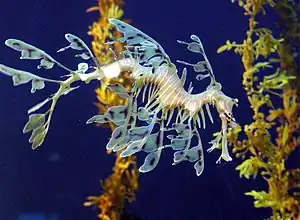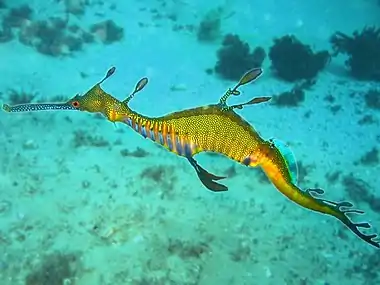| Syngnathidae | |
|---|---|
 | |
| Alligator pipefish, Syngnathoides biaculeatus | |
| Scientific classification | |
| Domain: | Eukaryota |
| Kingdom: | Animalia |
| Phylum: | Chordata |
| Class: | Actinopterygii |
| Clade: | Percomorpha |
| Order: | Syngnathiformes |
| Superfamily: | Syngnathoidea |
| Family: | Syngnathidae Rafinesque, 1810 |
| Subfamilies and genera | |
|
See text | |
The Syngnathidae is a family of fish which includes seahorses, pipefishes, and seadragons (Phycodurus and Phyllopteryx). The name is derived from Ancient Greek: σύν (syn), meaning "together", and γνάθος (gnathos), meaning "jaw".[1] The fused jaw is one of the traits that the entire family have in common.[2]
Description and biology
Syngnathids are found in temperate and tropical seas across the world. Most species inhabit shallow, coastal waters, but a few are known from the open ocean, especially in association with sargassum mats. They are characterised by their elongated snouts, fused jaws, the absence of pelvic fins, and by thick plates of bony armour covering their bodies. The armour gives them a rigid body, so they swim by rapidly fanning their fins. As a result, they are relatively slow compared with other fish but are able to control their movements with great precision, including hovering in place for extended periods.[3]
Uniquely, after syngnathid females lay their eggs, the male then fertilizes and carries the eggs during incubation, using one of several methods. Male seahorses have a specialized ventral brood pouch to carry the embryos, male sea dragons attach the eggs to their tails, and male pipefish may do either, depending on their species.[4] The most fundamental difference between the different lineages of the family Syngnathidae is the location of male brood pouch.[5] The two locations are on the tail (Urophori) and on the abdomen (Gastrophori).[6] There is also variation in Syngnathid pouch complexity with brood pouches ranging from simple ventral gluing areas to fully enclosed pouches.[7] In species with more developed, enclosed pouches it has been demonstrated that males directly provide their brood with not only nutrients[8] but also immunity to pathogens.[9] Syngnathids with more developed brood pouches are also known to be able to partially or completely abort a brood from a female with low fitness.[10]
A wide variety of mate choice and mating competition has been observed in Syngnathidae.[11] For example, Hippocampus fuscus exhibits conventional sex roles of males competing for female access[12] while Corythoichthys haematopterus is completely sex role reversed.[13] Most conventional sex role syngnathids are monogamous whereas sex role reversed species mostly exhibit polygamous behavior.[6]
Seahorses and pipefish also have a unique feeding mechanism, known as elastic recoil feeding. Although the mechanism is not well understood, seahorses and pipefish appear to have the ability to store energy from contraction of their epaxial muscles (used in upward head rotation), which they then release, resulting in extremely fast head rotation to accelerate their mouths towards unsuspecting prey.[14]
Evolution
Phylogenetic analysis implies that the most recent common ancestor of all syngnathids was likely pouchless. The family Solenostomidae (ghost pipefish) is a family in the order Syngnathiformes. Female ghost pipefish incubate their developing embryos inside fused pelvic fins. Evolutionary transitions from female to male care are practically nonexistent in teleosts, so brood pouches were likely not ancestral.[15] Genome sequencing supports this, revealing multiple different origins across and within different brood pouch types.[16] Oviparity was the ancestral trait, and the evolution of viviparity must have relied on the evolution and integration of multiple complex traits such as morphology, physiology, and behavior.
Syngnathidae was historically divided into two major lineages based on brood pouch location: Neophinae (located on the trunk) and Syngnathinae (located on the tail).[15] Genome sequencing shows a parallel increase in brood pouch complexity in both Neophinae and Syngnathinae.[16] Some species may have also independently evolved to have trunk brooding phenotypes, separate from the Neophinae. One example of this convergent evolution arises in pygmy seahorses (Hippocampus bargibanti, Hippocampus denise, Hippocampus pontohi). Pygmy seahorses are very small (about 1–2 cm tall) trunk brooders, phylogenetically surrounded by tail brooders. It's likely that the pygmy seahorse once had their brood pouch on their tail. The brood pouch may have moved locations when there was strong a correlated selection for a prehensile tail and diminutive size, resulting in a very small, trunk brooding organism.[15]
Viviparity and male-pregnancy in Syngnathidae have a complex evolutionary history with many independent origins of similar traits. Early members of the family developed traits to limit the presence of deleterious mutations, allowing for more rapid evolution.[17] The advantage of a more controlled and protected embryonic development seemed to be enough to enact evolutionary development throughout Syngnathidae to varying degrees.
In species with the most complex brood pouch systems, many traits (behavioral, physiological, morphological, and immunological) must have co‑evolved to allow for male pregnancy, driven by the increase of the fitness of those individuals’ offspring. The evolution of these traits resulted in a sex-role reversal in which females may exhibit competitive behavior for a mate.[18][19]
Recent research, especially whole-genome sequencing,[16] has allowed for greatly improved understanding of the evolutionary history of Syngnathidae, but there is still a need for further development in the field. Further investigations into the genetic mechanisms and selective motivation for the evolution of these traits in Syngnathidae may provide insight into the evolution of pregnancy separate from the female reproductive system.
Classification
- Subfamily Hippocampinae
- Genus Hippocampus (seahorses)
- Subfamily Syngnathinae (pipefishes, pipehorses and seadragons)
- Genus Acentronura
- Genus Amphelikturus
- Genus Anarchopterus
- Genus Apterygocampus
- Genus Bhanotia
- Genus Bryx
- Genus Bulbonaricus
- Genus Campichthys
- Genus Choeroichthys
- Genus Corythoichthys
- Genus Cosmocampus
- Genus Cylix
- Genus Doryichthys
- Genus Doryrhamphus
- Genus Dunckerocampus
- Genus Enneacampus
- Genus Entelurus
- Genus Festucalex
- Genus Filicampus
- Genus Halicampus
- Genus Haliichthys
- Genus Heraldia
- Genus Hippichthys
- Genus Histiogamphelus
- Genus Hypselognathus
- Genus Ichthyocampus
- Genus Idiotropiscis
- Genus Kaupus
- Genus Kimblaeus
- Genus Kyonemichthys
- Genus Leptoichthys
- Genus Leptonotus
- Genus Lissocampus
- Genus Maroubra
- Genus Micrognathus
- Genus Microphis
- Genus Minyichthys
- Genus Mitotichthys
- Genus Nannocampus
- Genus Nerophis
- Genus Notiocampus
- Genus Penetopteryx
- Genus Phoxocampus
- Genus Phycodurus
- Genus Phyllopteryx
- Genus Pseudophallus
- Genus Pugnaso
- Genus Siokunichthys
- Genus Solegnathus
- Genus Stigmatopora
- Genus Stipecampus
- Genus Syngnathoides
- Genus Syngnathus
- Genus Trachyrhamphus
- Genus Urocampus
- Genus Vanacampus
Images





 Skeleton of a banded pipefish (Dunckerocampus dactyliophorus) on display at the Museum of Osteology.
Skeleton of a banded pipefish (Dunckerocampus dactyliophorus) on display at the Museum of Osteology.
References
- ↑ Hentschel E, Wagner G (1990). Zoologisches Wörterbuch. Tiernamen, allgemeinbiologische, anatomische, physiologische Termini und biographische Daten (4th ed.). Stuttgart: Gustav Fischer.
- ↑ Lourie SA, Vincent AC, Hall HJ (1999). Seahorses: An Identification Guide to the World's Species and their Conversation. London: Project Seahorse.
- ↑ Orr JW, Pietsch TW (1998). Paxton JR, Eschmeyer WN (eds.). Encyclopedia of Fishes. San Diego: Academic Press. pp. 168–169. ISBN 0-12-547665-5.
- ↑ "Seahorses and their relatives". NSW Department of Primary Industries - Fisheries. Archived from the original on 2008-05-01. Retrieved 2008-06-13.
- ↑ Hamilton H, Saarman N, Short G, Sellas AB, Moore B, Hoang T, et al. (February 2017). "Molecular phylogeny and patterns of diversification in syngnathid fishes". Molecular Phylogenetics and Evolution. 107: 388–403. doi:10.1016/j.ympev.2016.10.003. PMID 27989632.
- 1 2 Wilson AB, Ahnesjö I, Vincent AC, Meyer A (June 2003). "The dynamics of male brooding, mating patterns, and sex roles in pipefishes and seahorses (family Syngnathidae)". Evolution; International Journal of Organic Evolution. 57 (6): 1374–1386. doi:10.1111/j.0014-3820.2003.tb00345.x. PMID 12894945. S2CID 16855358.
- ↑ Dawson CE (1985). Indo-Pacific pipefishes (Red Sea to the Americas). Ocean Springs, MS: Gulf Coast Research Laboratory. [as cited by Wilson et al. (2003)]
- ↑ Ripley JL, Foran CM (April 2009). "Direct evidence for embryonic uptake of paternally-derived nutrients in two pipefishes (Syngnathidae: Syngnathus spp.)". Journal of Comparative Physiology B. 179 (3): 325–333. doi:10.1007/s00360-008-0316-2. PMID 19005657. S2CID 22862461.
- ↑ Roth O, Klein V, Beemelmanns A, Scharsack JP, Reusch TB (December 2012). "Male pregnancy and biparental immune priming". The American Naturalist. 180 (6): 802–814. doi:10.1086/668081. PMID 23149404. S2CID 30248226.
- ↑ Paczolt KA, Jones AG (March 2010). "Post-copulatory sexual selection and sexual conflict in the evolution of male pregnancy". Nature. 464 (7287): 401–404. Bibcode:2010Natur.464..401P. doi:10.1038/nature08861. PMID 20237568. S2CID 1009344.
- ↑ Rosenqvist G, Berglund A (June 2011). "Sexual signals and mating patterns in Syngnathidae". Journal of Fish Biology. 78 (6): 1647–1661. doi:10.1111/j.1095-8649.2011.02972.x. PMID 21651521.
- ↑ Vincent AC (January 1994). "Seahorses exhibit conventional sex roles in mating competition, despite male pregnancy". Behaviour. 128 (1–2): 135–151. doi:10.1163/156853994X00082.
- ↑ Sogabe A, Yanagisawa Y (December 2007). "Sex-role reversal of a monogamous pipefish without higher potential reproductive rate in females". Proceedings. Biological Sciences. 274 (1628): 2959–2963. doi:10.1098/rspb.2007.1041. PMC 2291160. PMID 17878140.
- ↑ Van Wassenbergh S, Strother JA, Flammang BE, Ferry-Graham LA, Aerts P (March 2008). "Extremely fast prey capture in pipefish is powered by elastic recoil". Journal of the Royal Society, Interface. 5 (20): 285–296. doi:10.1098/rsif.2007.1124. PMC 2607401. PMID 17626004.
- 1 2 3 Whittington CM, Friesen CR (October 2020). "The evolution and physiology of male pregnancy in syngnathid fishes". Biological Reviews of the Cambridge Philosophical Society. 95 (5): 1252–1272. doi:10.1111/brv.12607. hdl:2123/31721. PMID 32372478. S2CID 218520770.
- 1 2 3 Hamilton H, Saarman N, Short G, Sellas AB, Moore B, Hoang T, et al. (February 2017). "Molecular phylogeny and patterns of diversification in syngnathid fishes". Molecular Phylogenetics and Evolution. 107: 388–403. doi:10.1016/j.ympev.2016.10.003. PMID 27989632.
- ↑ Wang X, Zhang Y, Zhang H, Qin G, Lin Q (June 2019). "Complete mitochondrial genomes of eight seahorses and pipefishes (Syngnathiformes: Syngnathidae): Insight into the adaptive radiation of syngnathid fishes". BMC Evolutionary Biology. 19 (1): 119. doi:10.1186/s12862-019-1430-3. PMC 6560779. PMID 31185889.
- ↑ Goncalves IB, Mobley KB, Ahnesjö I, Sagebakken G, Jones AG, Kvarnemo C (May 2010). "Reproductive compensation in broad-nosed pipefish females". Proceedings. Biological Sciences. 277 (1687): 1581–1587. doi:10.1098/rspb.2009.2290. PMC 2871843. PMID 20106851.
- ↑ Silva K, Almada VC, Vieira MN, Monteiro NM (2009). "Female reproductive tactics in a sex-role reversed pipefish: Scanning for male quality and number". Behavioral Ecology. 20 (4): 768–772. doi:10.1093/beheco/arp058. hdl:10.1093/beheco/arp058. ISSN 1465-7279.
External links
- "Syngnathidae" at the Encyclopedia of Life
- Froese, Rainer, and Daniel Pauly, eds. (2006). "Syngnathidae" in FishBase. January 2006 version.
- "Seahorses and their Relatives". NSW Department of Primary Industries - Fisheries. State of New South Wales. Archived from the original on 2008-05-01.
- Smith, JL (1963). "Fishes of the family Syngnathidae from the Red Sea and the Western Indian Ocean". Ichthyological Bulletin. Grahamstown: Department of Ichthyology, Rhodes University. (27). hdl:10962/d1019716.
